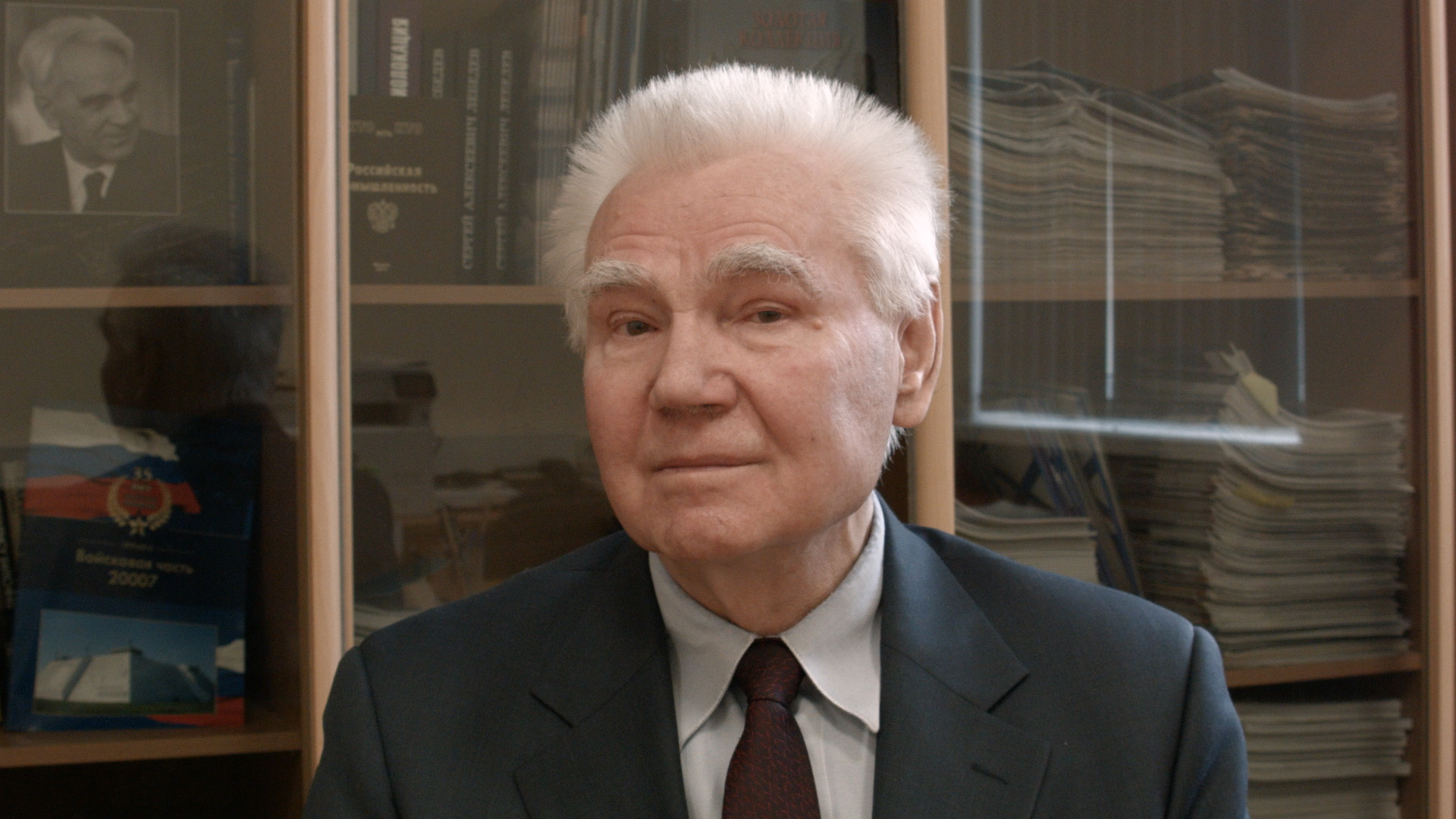
Doctor of Technical Sciences, Professor Yuri Ryabtsev is a graduate of the Moscow Institute of Physics and Technology , a long-term employee of ITMiVT and INEUM . In 1976, he became a laureate of a state prize for the development of a computer system for the S-300, in 1986 - a laureate of the Lenin Prize for the development of "Elbrus-2." In an interview from our historical series, Yuri Stepanovich tells how engineers were trained for advanced defense programs, explains how institutions and entire industries interacted in the USSR, and shares his views on major Soviet IT projects.
From the village to the best university in the country
- I graduated from a village school in 1953, when young people raved about atomic problems, and I also really wanted to do atomic physics. Therefore, the first thing that I began to watch was the Moscow Engineering Physics Institute. I almost filed documents there, when I suddenly saw an announcement that there was another institute - the Moscow Physicotechnical Institute, which had exams a month earlier. This meant that two entry attempts could be made.
Entrance examinations were held in the building of the Moscow Power Engineering Institute, and there was a hostel there. About 10-15 days before the start, Fizteh gave us his math and physics puzzles, and I realized that I can’t solve 90-95%. He began to go to all the consultations, and people led them to universities for non-standard. Young scientists from the Physics Institute of the Academy of Sciences consulted in physics, and guys from the Mathematical Institute advised in mathematics. All explained easily and freely. As a result, I solved 95% of the tasks for the exams.
- How did the village teachers prepare you for the institute?
- Our school was one in the entire Kurovsky district - now it is Orekhovo-Zuevsky, and the village of Kurovskaya is now called the city of Kurovskoye. Half of the class went to high school on foot from the surrounding villages. But they taught us, one might say, populists. Very dedicated teachers who have been busy with us all the time. In mathematics and physics, I was an excellent student, they tried so that I would solve more problems. Once there was a failure: the test in mathematics did not work out for me. Usually in such cases they put a deuce, but the teacher said: "I will prepare for the next lesson, and you decide." She sat with me for another two hours, because psychologically it was very important for me to cope with these tasks. The teacher did not let me break, lose confidence in myself.

View of the Kurovsky textile mill, 1950s The status of the city the working village of Kurovskoye received only in 1952
At the entrance exams in mathematics and physics, I had the best points in the group. He wrote the composition well, and the German teacher said: “You have a good voice timbre. You will learn English, because it is useless to teach German to you. ”
- Was it difficult at the institute?
- Highly. Fizteh is a university in which there were no thieves, because they do not go to hard labor. In the first year they put 56 class hours per week with a mandatory presence. Plus several hundred pages of foreign texts and several pages of task numbers. How we stood, I do not know. This was the main selection, someone could not cope. The group we had 16 people, finished 11.

MIPT Laboratory Building, 1950s
This institute was created in a targeted way to solve strategic problems, therefore, those who work at the most advanced level of knowledge of each industry should have been taught. For three years, we took a university course in mathematics, physics, and everything else, and then we were sent to the basic institute - ITMiVT (Institute of Precision Mechanics and Computer Engineering).
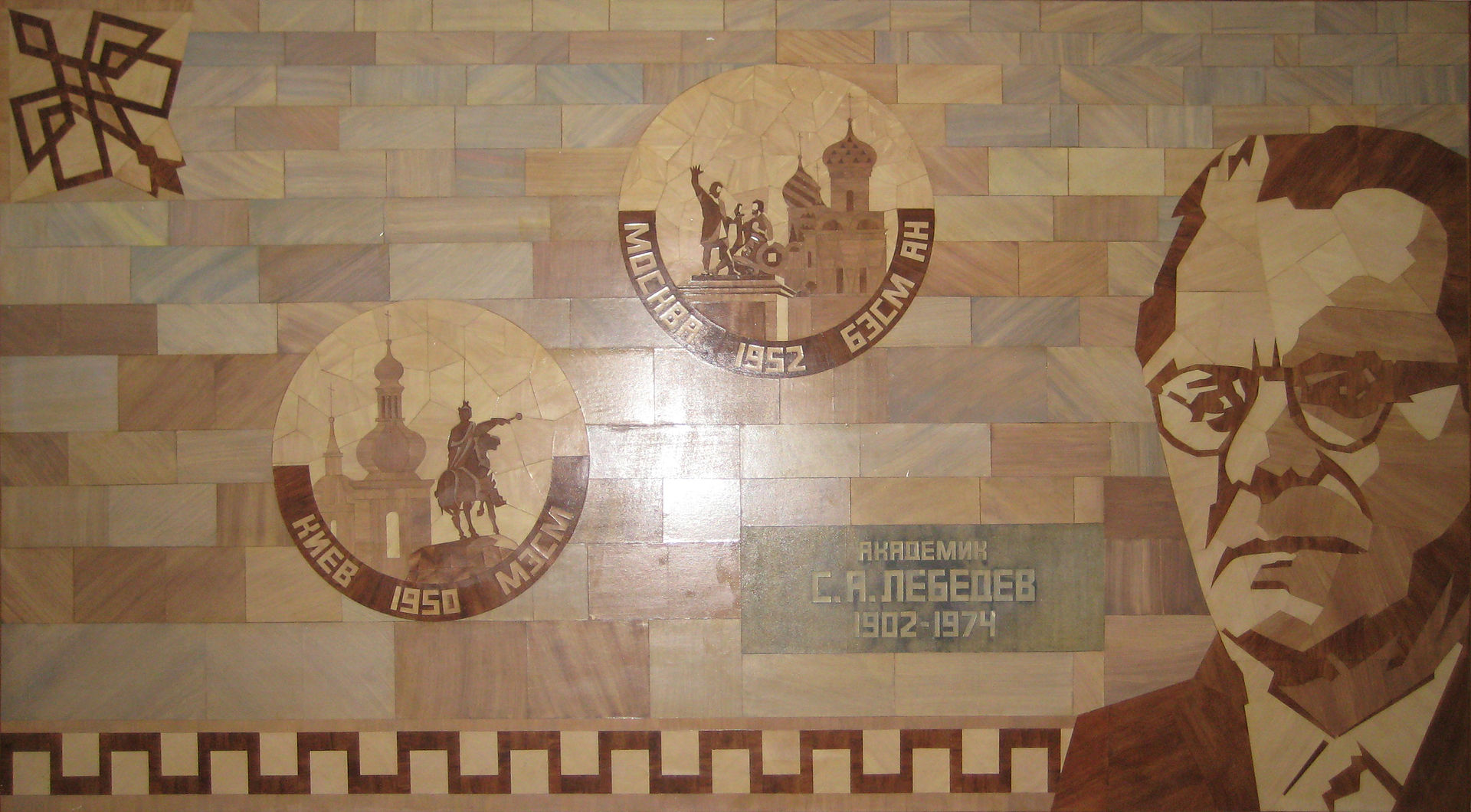
ITMiVT. Mosaic from different species of wood, dedicated to the memory of academician Sergei Lebedev, who headed the institute for more than 20 years
- You chose computer technology yourself?
- Upon admission to Fiztekh, in addition to exams, an interview was conducted. Wise people sat, looked at us, asked. I was asked the only question, because the person from the commission knew our village. “Are you familiar with such and such?” - “Yes.” This is the end of the interview. They said: "Go to computer technology." I did not resist, because I didn’t know what it was.
- What were the alternatives?
- In Fiztekh there were 16 groups and 16 directions - the range is very large. From physical chemistry to aeromechanics, these are rockets and aircraft construction. Faculty of Radio Engineering. The Faculty of Automation, in my opinion, was.
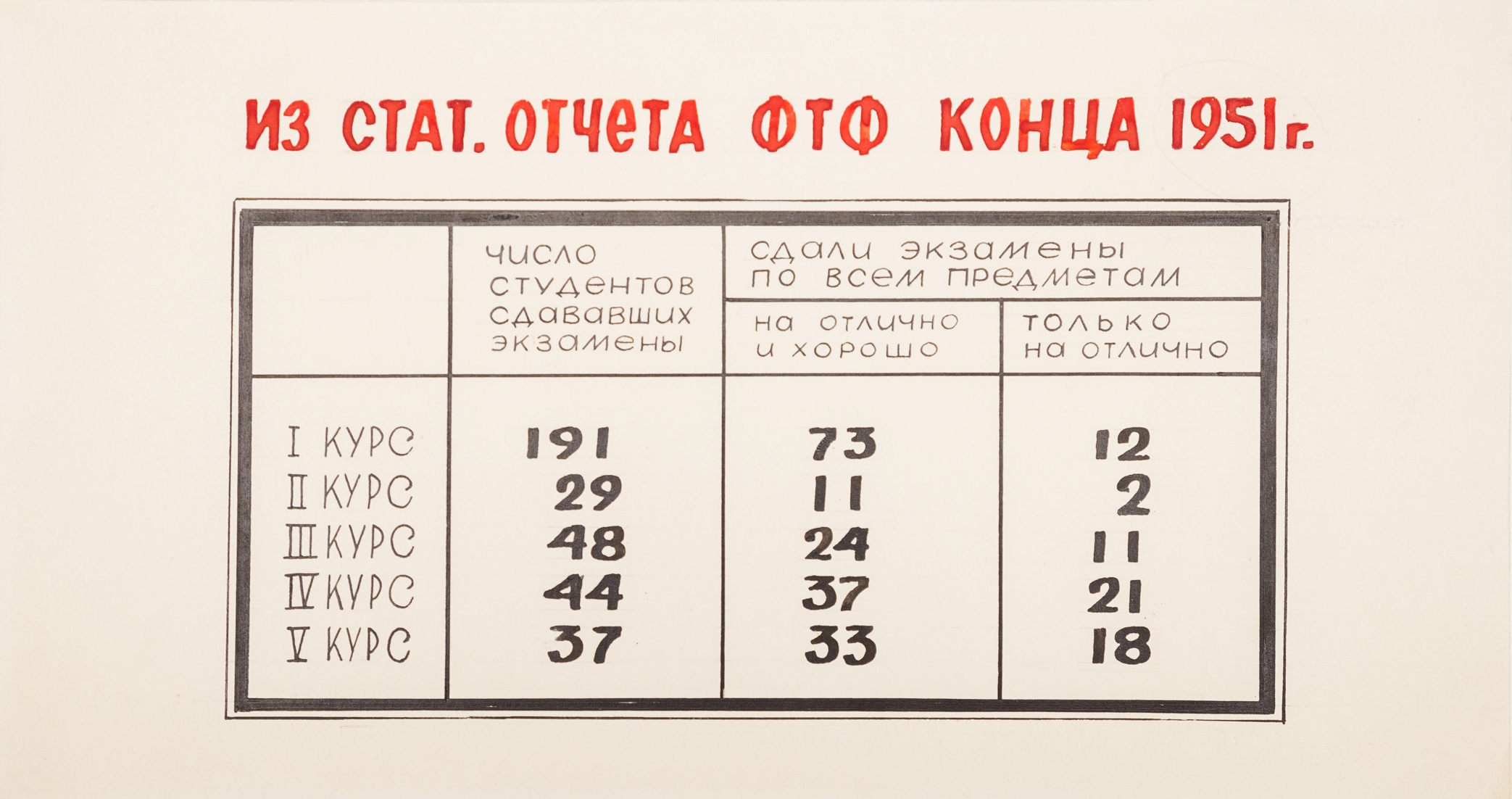
In the first year, not all exams passed. From a report for 1951: PhysTech is also called FTF - Physics and Technology Faculty of Moscow State University
The training suggested that from the 4th year we spend most of the time at the base enterprise. There is a department, and lectures, and work. First, we were attached to the laboratory, in the last courses we were enrolled part-time, for example, by technicians. About a year was allotted for the diploma, then a relatively natural distribution. The Institute could not provide housing, so about half of the students remained at the base enterprise. Someone was leaving for Novosibirsk.
Ballistic missile interception and Gagarin’s flight
- That is, starting from the 4th year, were you constantly at ITMiVT?
- I had a very hardworking leader, he pulled me into the development of new elements - then only transistors appeared, before that there were lamp machines. I mastered all this technique, defended a diploma in it. Then a modification of these elements was in the first computer that I designed.
- What was that car?
- 5E92b . This is a military designation, a second generation machine for missile defense systems. In the early 60s, we made it - prototypes. Tested at the training ground, our teams went there to put into operation. And on the basis of this machine was created the first combat missile defense system. Two years ago, the car was still working, but not in combat mode.
- The tasks of such a machine - location, miscalculations of the trajectories?
- The locators themselves are developing radio engineering enterprises, information processing - at the expense of our computers. The missile defense system was the first complex system in the world where a digital computer was built into the control loop (in air defense systems of that time, an operator was built into the control loop, relying on analogue devices limited in capabilities). A computer was objectively necessary. The sites were located at a distance of 100-200 km from each other. Launch pad, location, command post. It was necessary to ensure communication between them, the collection of information, processing, guidance. The first interception of a ballistic missile, which occurred on March 4, 1961, is an event approximately equal in value to Gagarin’s flight.
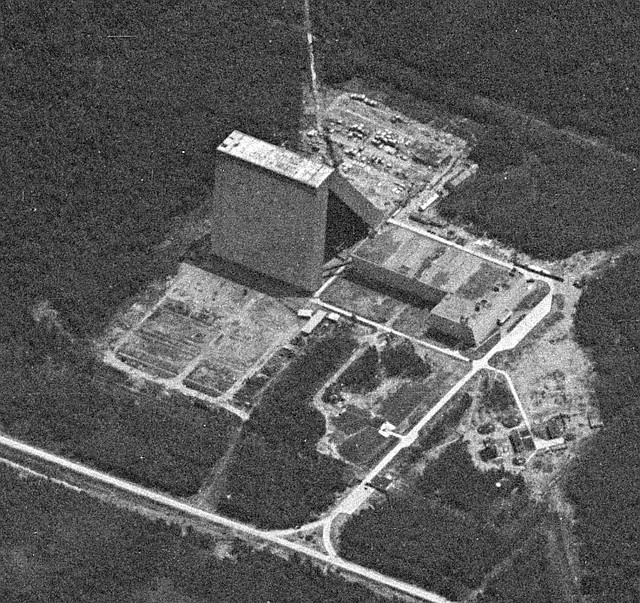
Declassified image of the American reconnaissance satellite KH-7. In June 1967, he photographed an element of the A-35 system at a missile defense station in Moscow’s industrial areas in Kubinka. A-shaped building - locator nicknamed the hut
I think few people imagine what Gagarin’s launch into orbit is, because our writers and journalists have distorted the picture very much, I would even say, they vulgarized it. It has always been a mystery to me how a healthy 30-year-old man who has two children is seriously risking his life in order to, excuse me, wave his hand somewhere out there in space. Why the hell does he need it? And just recently I read that Gagarin’s flight was carried out at the suggestion of four prominent people, including the “three K”: Korolev, Kurchatov and Keldysh. They wrote a letter to the Politburo about the strategic task of launching reconnaissance satellites, and there, with a special solution, they allocated 7 missiles for working out the first flight.
The feat that Gagarin performed is much higher than waving his hand in space. His flight showed that the USSR already has a powerful (the weight of the cabin exceeded the possible weight of the warhead), reliable (only using reliable equipment can launch a man) missile, which can seriously threaten the aggressor and serve as a base for deploying intelligence systems. Successful interception of a rocket showed that the USSR has detection locators, precision pointing locators, a high-speed interceptor missile and a digital computer capable of providing automatic control of interception. These two events have shown that it is better not to touch the Soviet Union.
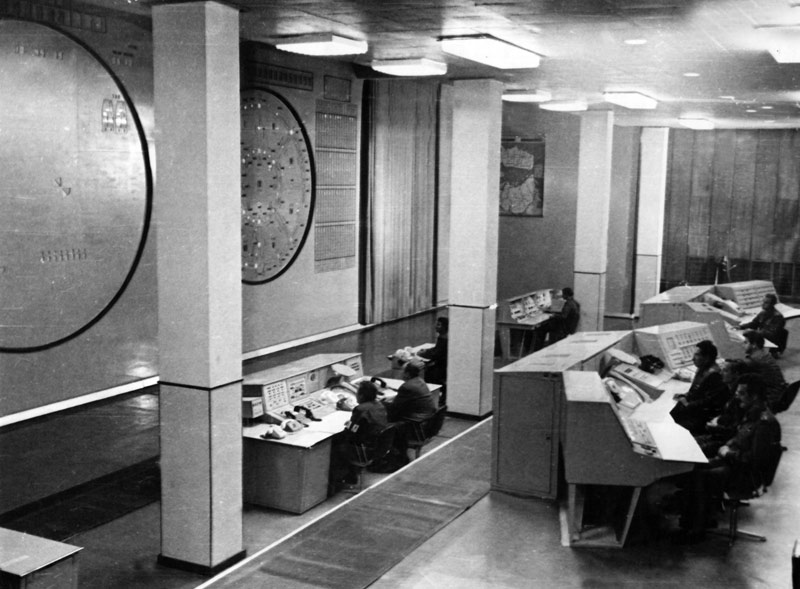
The main command and computing center of the A-35 missile defense system in Kubinka
History of ITMiVT
- ITMiVT has always been on strategic management. His task was to make the fastest cars that are possible in our country. They were needed everywhere. All attendants had the first form of admission, that is, admission to top secret documents of special importance. When the first classic BESM machine was made, I did not immediately find out about it. Periodically, the engine room was closed, security appeared. Of the famous personalities, Sakharov came to calculate his hydrogen bomb.
Prior to this, all calculations were carried out by the so-called settlement bureaus - our institute had a large unit consisting of women with arithmometers. And when there was at least some kind of machine that allows you to consider much more productive, it was already a sharp leap forward. Tasks like flying around the moon have gone. This is also one of the areas close to intelligence technology. Volumetric calculations for all trajectories were performed with us.
When BESM-6 cars appeared, less than 400 of them were produced, and distributed only by government decisions. Several of them stood at universities, Academy of Sciences of the USSR, and the majority: at Arzamas-16, Chelyabinsk-40, at the space control center, at the mission control center, etc.
- At the PhysTech, a lot of attention was paid to a foreign language. Did you have access to foreign publications?
- At first, we were provided with closed literature. Magazines were received, interesting materials came to us from IBM. It was a real school of competent engineering work. If you are doing something, be sure to correctly report on it, and they still have this style.

Cover of IBM Systems journal No. 3-4, 1968
Something very serious from there we did not learn. There was one material in which the further development of computer technology was predicted in the early 60s. He was remembered to me by the fact that nothing came true. Then such materials ceased to come to us, and they were not particularly needed. If you yourself cannot solve the problem, copying is pointless. Because the main thing in our business is mistakes. What do you think our company is doing? 90 percent - looking for errors. They quickly drew a diagram, and then drove for several years. First, on a simulator, that is, on a computer. Then on specially made equipment - this is the so-called prototype, which works only 50 times slower than the designed processor. So, you can drive big tasks on it. Mistakes - they are always native, no one will help you with them. That two, two, four, prompt, but what to do next, understand it yourself, and this is the most important thing.
For a long time I was trying to understand why ITMiVT and other similar enterprises arose. They were created in 1949 or so. What for? Remember the phrase Stalin said in 1931: "If we do not run this gap in 10 years, they will crush us." She defined the whole life of the country in the pre-war era, including repression, the tragedy of collectivization.
After the war, the situation was the same. Our people got out. There was a plan to defeat us - bam, tanks were made. The Americans accumulated 300-400 bombs, and we have only a dozen - they began to create them forcefully. No delivery vehicles? They created the Myasishevsky bomber. Then they created a royal rocket. There were few of them, as they say - during the Cuban crisis, there was only one combat ready, but it could already cause serious damage. Survived this period.
ITMiVT was created out of good intentions, but at first things went neither shaky, nor roll. They collected several laboratories from the Academy of Sciences, put them together, but there was no particular sense in this. And the Central Committee sent his man, Yuri Zhdanov, to check the state of affairs at the Academy of Sciences. As a result, he wrote a letter, one and a half pages devoted to ITMiVT. On the contingent, leadership, stupidity. After that, the outstanding scientist and organizer Mikhail Alekseevich Lavrentiev, academician, was sent here. Then he created the Novosibirsk Academgorodok. Personally.
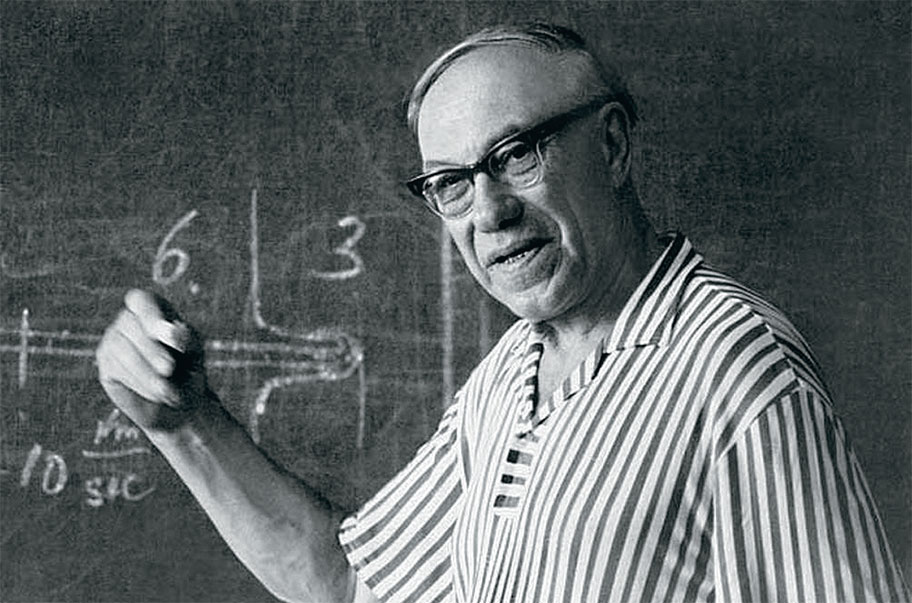
Mikhail Lavrentiev was elected Director of ITMiVT in 1950
We did not have it for very long, about a year and a half. Immediately he cleaned 40 percent out of use, set the condition for Lebedev to lead the institute. Then a special group of students from the Energy Institute was sent here, which was prepared on the instructions of Beria, who oversaw all the most important areas. It was created for the atomic project, but Lavrentiev managed to persuade Beria to redirect this group here. It included about 20 students who defended their diplomas here. The selection was very serious, and therefore 2 academicians, 4 doctors of sciences left this group. Almost all became laureates of the State and Lenin Prizes.
These people became the foundation of the first car. Because they drew it well, but it was very unreliable. Refused in a half to two hours, and it was necessary to fix it in 15 minutes.
Back in the First World War, when there was complete confusion and nothing was missing - no ammunition, no chemicals - a commission was created to mobilize natural resources. There included the shipbuilder Krylov, the future academician Vernadsky, the outstanding chemist Kurnakov. They formulated rules for how to survive, and the GOELRO plan came out of these circles. In the 1930s, they formulated rules on how science should be developed. It should be based on an enterprise or organization in which there is everything: researchers, developers, technologists, testers. The whole bouquet should be in one place and focused on solving the main problems. This enterprise can be called - the enterprise of BIG SCIENCE. Most of our efficient enterprises were built on this principle. Including ITMiVT. There have been many naive studies, but it always happens: when they research something, a substantial part then disappears somewhere. But qualifications remain.
Then it became sad for some to sit with tolerances for secret work (without going abroad). According to the memoirs of the "major scientist" Gvishiani, talking with his father-in-law Kosygin, he heard: "We need to distinguish pure science." Then the Academy of Sciences began to rot. What is happening to her now is the echoes of the 1960s. Then ITM&VT left the Academy of Sciences and was included in the Ministry of Radio Industry. We learned how to connect a lot of enterprises of the country to the development. There was such a body - the military-industrial commission under the Presidium of the Council of Ministers. That is, the Central Committee and the Council of Ministers made basic decisions on the allocation of money, and the military-industrial commission implemented them. Sometimes 10-20 million rubles were spent through my department every year, now it is 30-50 million dollars. When we did the Elbrus, it took about 300-400 million rubles (at today's rate - more than a billion dollars), a third - for allies.
Cars
- The main series of well-known machines made by ITMiVT is BESM. Were there other options available?
- They are all described in our books. The BESM line gave an incredible surge in the form of a BESM-6 machine. This was the effect of second-generation developers. When you do the first project, you still don’t know much, try, make mistakes. But the second can turn out brilliant. BESM-6 was made mainly by guys from MPEI. The main person in this project is Andrei Andreyevich Sokolov. He was engaged in construction, and electronics, and architecture. It is believed that all this was planned by Lebedev, but Sergey Alekseevich was already elderly.
Further machines began to improve this line. The AS-6 was released, which became the basis of the MCC (Mission Control Center) in Korolev. In parallel, a group of units for the development of special vehicles was formed at ITMiVT.

The Metropol Restaurant, 1960s
The history of this trend is quite funny. I have already said that the first BESM was served by young intelligent engineers. They paid them well in the mid-1950s - 1800 rubles plus bonuses, which is significantly more than other colleagues. For young people at that time it was a lot of money. And they lit up in the Metropol restaurant, where it was categorically contraindicated to go, because all the tables were auditioned there. After the report from the special services, they were denied access and, therefore, were forbidden to work at BESM. Sergey Alekseevich Lebedev then said: “Let's do special equipment.” And so they made the first computer for controlling flight of aircraft, which, however, was never released in series.
The development of a missile defense system is another serious area of ITM and VT. The predecessor of BESM-6 was the M-20 lamp machine, and the M-20 understudy was the M-40, which was part of the control circuit of the first stage of the ABM system. All these tests were carried out on it - interception of a ballistic missile and others. The next generation - 5E92b - is already a semiconductor machine with significantly higher performance than the M-40, and much more reliable for the first stage of the Moscow missile defense system. One of the machines of this generation created at ITM and VT, as I was told, worked two or three years ago in Kamchatka. She monitored the launch of missiles from the American atoll Kwajalein - there the Americans conduct all missile defense tests. On the basis of this machine was made air defense system, the prototype of the S-300. The Americans fought in hysteria and yet did not allow its use in the OSV-1 treaty .
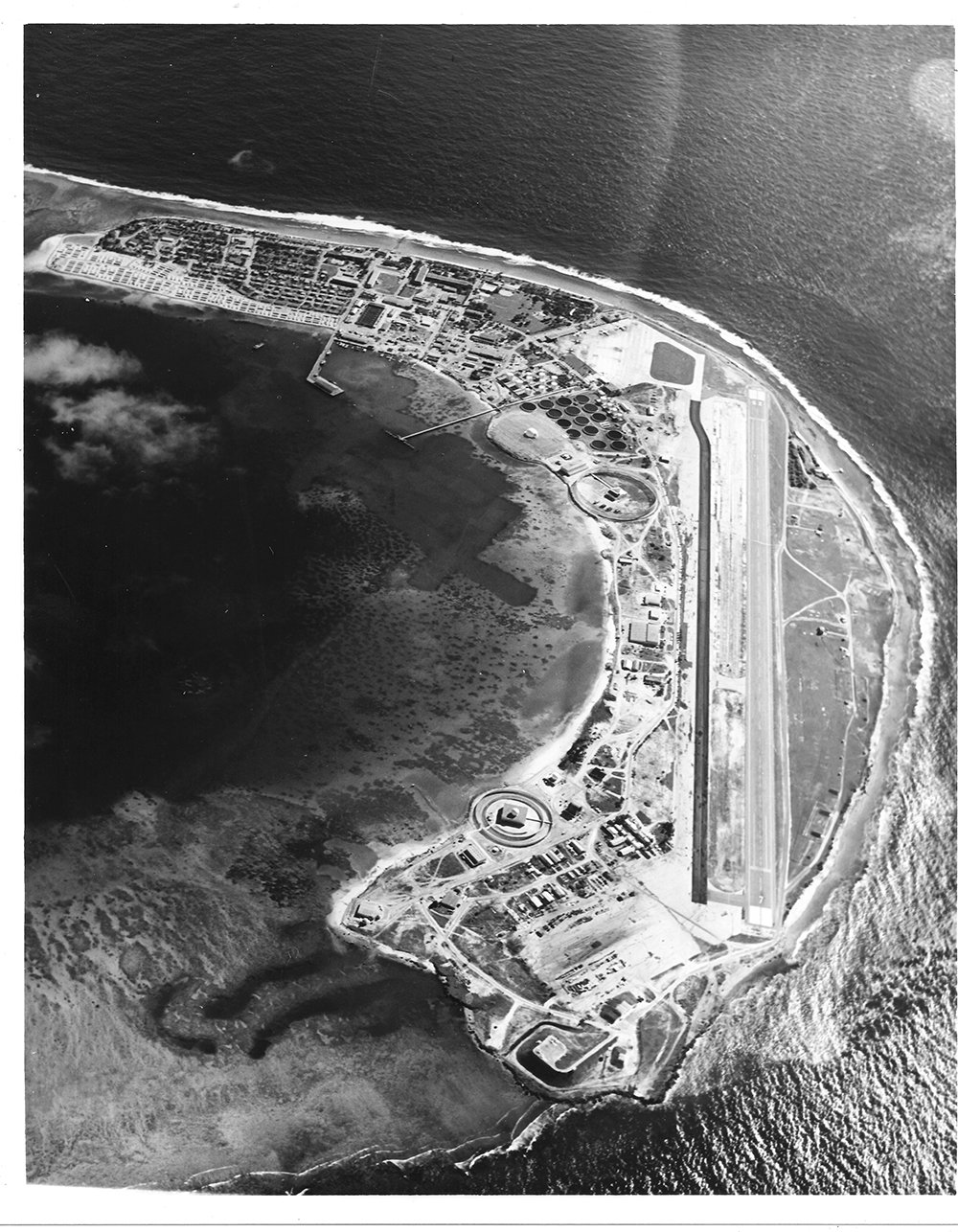
US Army Test Site at Kwajalein Atoll, 1960s
The development of special vehicles divided the industry into two more directions. One is air defense systems (S-300 and others) and missile defense systems. The missile defense was provided by 5E92b special vehicles, and when the next generation needed significantly more powerful computing equipment, the Elbrus family was created. It still works in various systems.
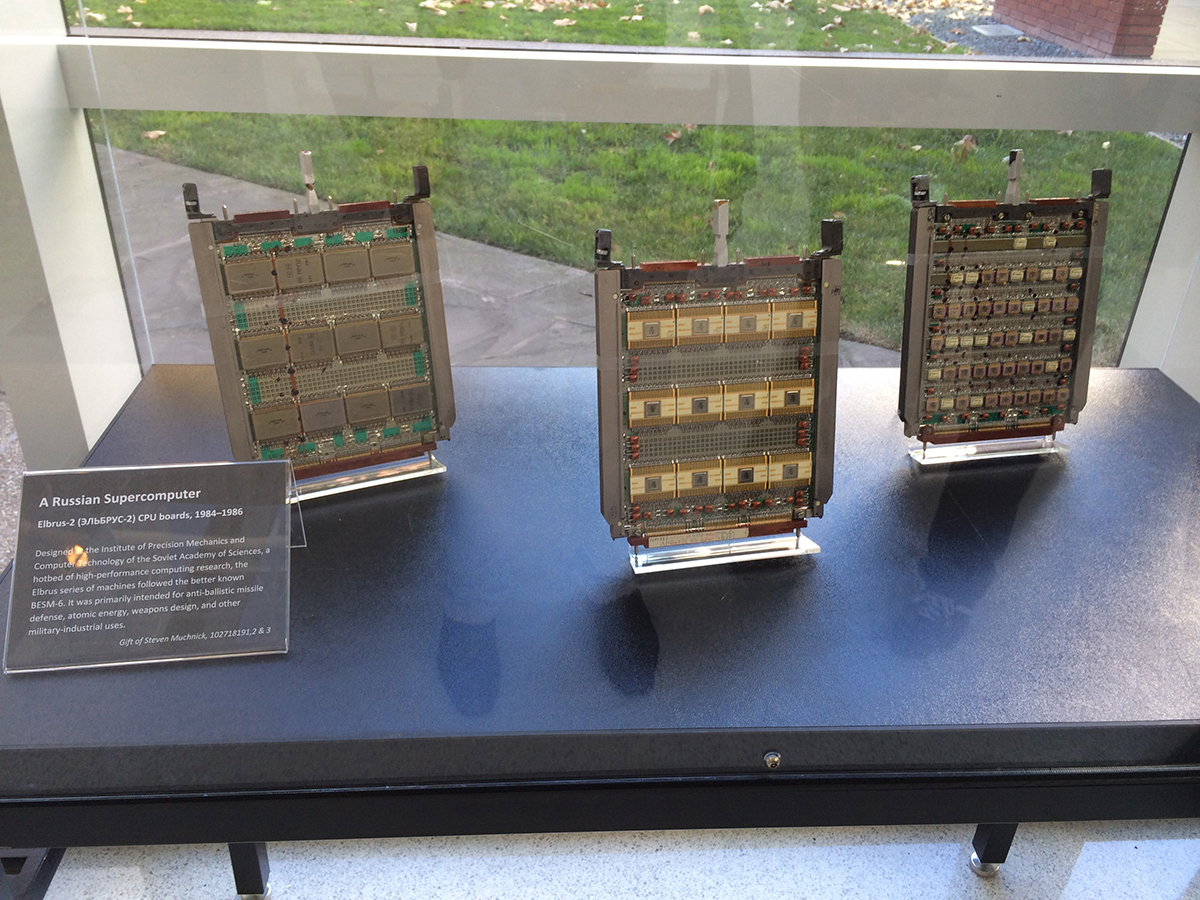
A stand with parts of the Elbrus-2 computer processor at the California Museum of Computer Engineering. Photo sent by a former ITM&VT resident in the USA
Healthy stay
- Physicists, lyrics. Did you somehow feel the intersection of the two cultures?
- Next to us was the Physics Institute of the Academy of Sciences, which served as a real party place for everyone. Someone read samizdat. Among those who were engaged in serious business, many are well aware of literature. The penultimate in the USSR general designer of the ABM system periodically educated us - quoted Eugene Onegin by heart, at meetings brought some figurative expressions to the place. The general designer of the first missile defense Kisunko sang - I saw this in the documentary. Is he a lyricist or a physicist? Probably both.
We, the children of war, have experienced very difficult times. Almost died in evacuation with my sister - there was no normal food. After the war, there was another famine - for culture, knowledge. Combed all the museums. In the Russian Museum, I definitely went into the hall of Kuindzhi. If at the conservatory - then it is no longer just randomly noted, but to certain performers, authors. On Van Cliburn, for example. My wife stood in line at night so we could go there.
Van Cliburn performs the arrangement of Vasily Solovyov-Sedogo’s song “Moscow Nights”. Concert at the Moscow Conservatory, April 2, 1958
- The story about the Metropol is funny. How else did you spend your free time?
- Somehow everything revolved around sports, physical education. They loved to break out into the countryside, mastered water skiing, and made boats themselves. Then came the skiing fashion, rode out with entire teams. In those years, I’ve been to the mountains 20 times, I traveled almost all the mountains of the USSR. This formed the spirit of collectivism, camaraderie, which greatly helped in the work.
Here is a personal example. I have always been, relatively speaking, the main in its part. It doesn’t matter what the position was called, everyone knew that I was responsible for the iron of the machine. Operatives were periodically conducted at the Moscow Region facilities. When a car was made for a three hundredth system, we went to the Zagorsk plant every two weeks. And in the manufacture of a prototype VK for the S-300 were at a standstill - we can not check the modules. New technology - integrated circuits have appeared. The modules have become much more complicated, there are no control methods, but you can’t check them manually - you’ll kill some dangling transactions. This did not concern me at all, but the situation was tense. He began to think, recalled how several years ago he worked as part of a group that tested poorly functioning communications equipment in Brezhnev’s car. The tricks used then came in handy now. Together with the technician, we mounted a prototype, called the chief designer: "Here's how to check." He looked and immediately invited a very good engineer Oleg Gurkovsky. He worked out the methodology in three weeks, after which we did not know any problems for 15-20 years. This is the work of the team.
No miracles
- Changes in the element base - the transition from lamps to transistors - were perceived as an incredible breakthrough?
- It was a natural process, no miracles. A key invention in integrated circuits is the so-called planar transistor. We used it, then we realized that they can be made in pairs - from this new circuit solutions are obtained. Then they began to group, schemes appeared that were pure prototypes of old solutions, only technologically new. We quickly mastered them. They worked continuously in contact with Zelenograd institutes. According to our tasks, they developed a series of microcircuits, we put them in a car.
The strength of integrated circuitry is in natural evolutionary development. No brilliant insights. Everyone finds something, eliminates another problem. The number of defects decreases, the circuit becomes more complicated, and the resolution increases. When I had to prepare a decision of the military-industrial commission on the S-300, I was wound around all institutes and factories. Communicated directly with specialists who made the system. I ask: “What problems prevent the production of integrated circuits of a higher level?” “The first is water,” they say, “the specific resistance of purified water should be at least 100 megaohms. This is the main material for washing, it is used everywhere. The second is a micrometer screw with great accuracy, because thanks to it a photo mask is drawn. And optics with a resolution line of 2000 lines per millimeter. We solve all other problems ourselves. ”
Development is about the same now, only the names have changed. We need ultrapure hydrogen, because if it is slightly different, all your stoves will go to landfill - they will become clogged. We need ultra-precise coordiographs, etc. Now it is very difficult to give. Attempts to buy a whole factory for the production of LSI (large integrated circuits) were. But it was already the sixth or seventh year that they had spent one and a half billion dollars, and the equipment was not put into operation. Because they did not purchase specific knowledge.
- When the first Intel 4004 microprocessor appeared, how did the community perceive it?
- Fine. At the end of the 80s, we developed our own Elbrus-90 microprocessor. He disappeared, but his developer became the lead developer at Intel. This is Pentkovsky Volodya, winner of the State Prize for "Elbrus-2". They even said that Pentium was named after him, but this is not so.
Age of Interaction
- In parallel with ITMiVT, other Soviet institutes worked. Have you contacted them?
- Such contacts, so that knowledge flowed, unfortunately, were not. They had to be organized centrally, and so, when the project was ending, I was completely uninterested in how someone else was doing a parallel version. It was necessary to move on to new tasks that no one would solve for us. Some specialized enterprises worked on our assignments. It was a business constructive interaction, but ideas and knowledge were not transmitted. If you decide, you decide.
INEUM, say, was engaged in a completely different direction. We made the fastest cars, and they were control systems for nuclear power plants, distillation plants, and the subway. There you do not need high performance, but reliability is required, first of all - system.
The approaches were different. Someone copied the American circuitry for the EU computer, someone made the Elbrus line - our independent project. They laughed at us when we introduced the liquid cooling system at Elbrus. At first it was a bit of amateur radio: “Let's try and see how it works.” Then it turned out that without this there would have been no missile defense system. Because the power needed is big, and the announced amount is allocated heat. About 1000 kilowatts per room. If you remove the excess air, drag the ducts, you have to pump 360 cubic meters per hour per kilowatt. You break all the ceilings with the air ducts and you won’t do anything, and cooling the system with water is quick and easy.
When we solved the problem of testing the modules and lived quietly, everyone giggled. “How so? This cannot be, because it can never be! ”But it works for us! At the Minsk plant for the production of computers, people lurked heavily. They really couldn’t check the modules, they stuffed them into cars and searched for a month which system failed. Then they came to us at the Zagorsk Electromechanical Plant: "What to do?" We: "Bring the modules, we will check them according to our methodology." Minskers compiled a list of faults, their testing methodology revealed approximately 80% of defects, ours - 99.9%. Moreover, our staff are girls after school. We train them for two days, and they work.
From the era of interaction, competitiveness is recalled. In the EU there was a computer the fastest machine - in my opinion, 1066 - uniprocessor. Somewhere in the early 1980s, we compared its performance with Elbrus. , . — . : « !». : «. . ». , . , . , — .
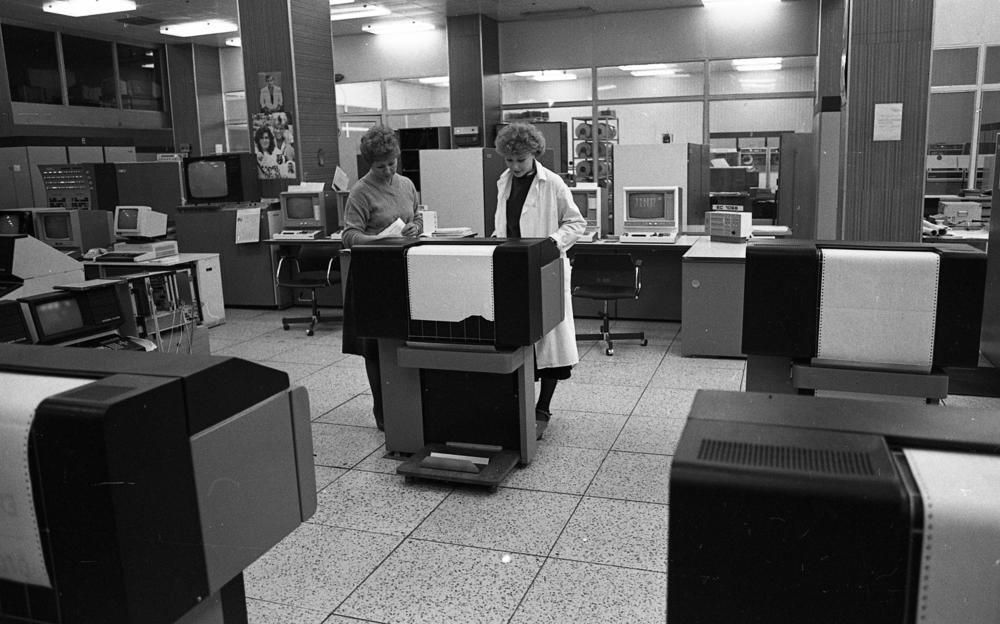
-1066, 1990 .
. «-3». , «-2», . . , . , . , . , — . . , . 6 , 20 20 — . 100 . : , . , . , , . , , — , . , .

«» . . .
— 1980- , ?
— 1991 . , . . . , , . - , . — . , , Sun, . «», . — , . , .
— Intel.
— — , . 15 «» . Intel , , . . , , . , — , , . , , . . , .
— ?
— . , . , — . .
— ?
— , , , . : , . , . . . ? ? . . .
— , , ?
— . . , — 12 . . , — . , . . , , , .
, — - . , - , . . : . - , , . ? . , . . . — 15 , — 15 . , - . . ? How?
, , , . , , , , . , . , , . — . , , . , , . , 592 .
() -300. ( ) , . () . , . .
, : «, , . , ». , . .
. , — . .

«-3»
, .